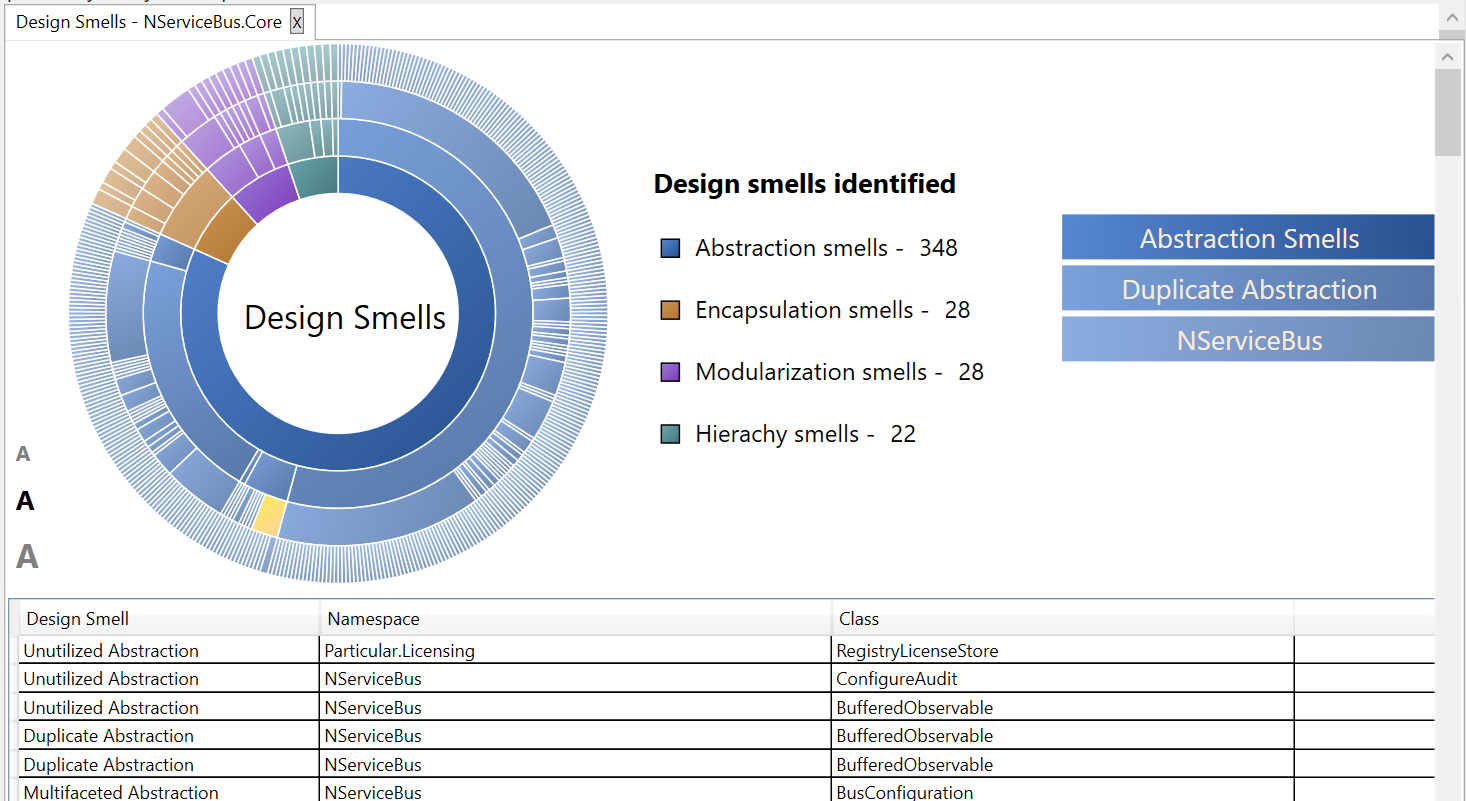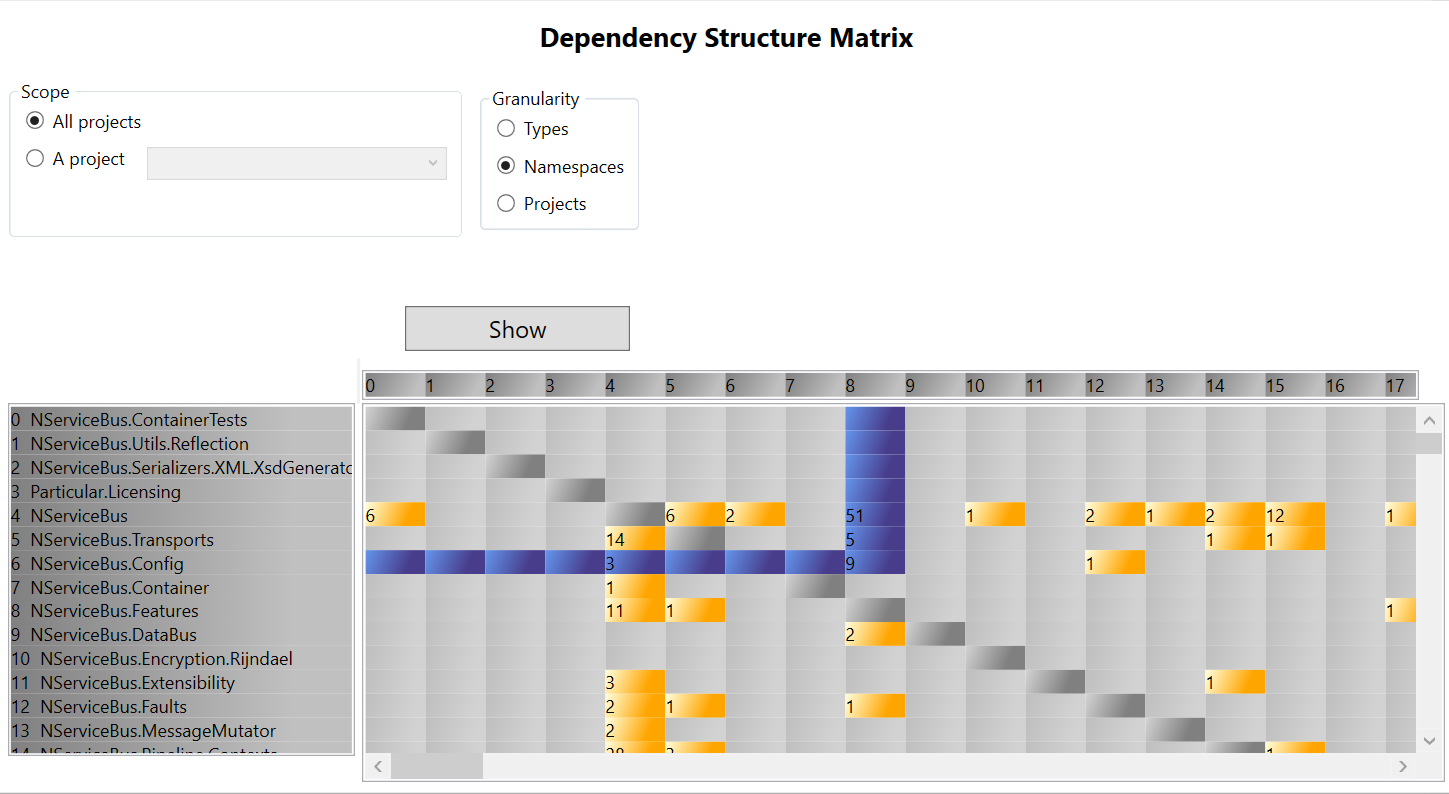Designite is a software design quality assessment tool. It analyzes C# codebase and detects a comprehensive set of architecture, design, and implementation smells. Currently, Designite supports detection of 7 common architecture, 19 design, and 11 implementation smells. Designite computes more than 30 source code metrics to gauge the structural health of a software system. Designite offers a rich set of visualizations for software developers, designers, and architects to visualize various issues affecting the maintainability of their software. These visualizations include sunburst diagram for showing detected smells, treemap diagram for visualizing the distribution of smells in a codebase, and a pie-chart of the metrics for holistically visualizing the state of the code from a specific metrics point of view. Additionally, the tool supports detection of code clones, prepares DSM (Dependency Structure Matrix), and performs trend analysis showing the number of smells remained, refactored, and introduced in a new version from its previous version. Features1. Detect Architecture SmellsThe quality of your architecture decides vital quality parameters of your software product. Designite detects various architecture smells in your code to help you help you improve the agility of your software. The following architecture smells are detectable by Designite:
2. Detect Design SmellsDesignite detects various design smells in your code to help you manage your "design debt". Designite identifies design smells and presents them in a view that classifies them based on the fundamental principle they violate. In addition, Designite also points out the cause of the smell and therefore provides a clue towards refactoring of the smell.
The following design smells are detectable by Designite:
3. Compute MetricsDesignite computes object-oriented design metrics that are helpful to gauge the structural health of the software project. Designite classifies these metrics in four categories: solution-level metrics, project-level metrics, method-level metrics and class-level metrics. Designite highlights specific metric values that violate metric threshold as a metric violation in a different color to help you spot the violations.
4. Analyze TrendDesignite supports "trend analysis" to reveal the evolution of software from the smells perspective. Specifically, the trend shows how many smells (both design and implementation) have been introduced, remained, and removed from one version to another. It is useful when the development team wanted to observe the quality of the software, especially after a refactoring cycle. 5. Smell Distribution (Treemap)Designite allows the user to see the distribution of design and implementation smells using Treemap. The smell treemap shows two dimensions - size of classes/namespace and corresponding severity of smell density. The diagram shows the severity of smell density using intuitive color scheme; smell density increases from green to red. 6. Dependency Structure MatrixThe Dependency Structure Matrix (DSM) is a compact and visual representation of dependencies (with corresponding strength) among software system entities (such as Type, Namespace, or Project) in the form of a square matrix. Designite offers an interactive and simple yet effective implementation of DSM.
7. Detect Implementation SmellsDesignite supports a variety of smells that may occur at implementation level as well (in addition to design smells). Refactoring these smells lead to better code quality.Designite supports detection of the following implementation smells:
8. Identify Code ClonesDesignite detects code duplication in your code and reports design smells based on the identified clones. The identified code clones can be further analyzed manually by exploring the excel sheet generated by Designite that contains information associated with code clones along with the identified design smells and metrics. 9. Console ApplicationDesignite provides a console application with various options to allow integration with external tools. For instance, one can integrate Designite with SonarQube to see the design smells detected by Designite in SonarQube. The new console application not only supports previously supported functionality (analyze projects and export results in MS Excel, XML, or CSV formats) but also allows a user to carry out trend analysis with a rich set of options. 10. Customize Your Quality AnalysisEvery piece of code is different in terms of domain, context, and its quality requirements. Measuring quality aspects of all the software systems using the same stick is not appropriate and often not desirable. Keeping it in mind, Designite has introduced a new feature "Preferences" in version 1.33.0 to allow users to customize their analysis by selecting thresholds based on their context and requirements. 11. Identify HotspotsThe hotspot analysis assigns a "Hotspot score" to each class based on the detected design smells in the class and highlights the classes that you may choose for refactoring first. 12. Export ResultsDesignite allows you to export the analyzed information (detected smells and computed metrics). Three export formats are available to choose from: MS Excel, XML, and CSV. This extremely useful feature allows you to share the result of the tool with other stakeholders in your team and analyze the results further. Which problems can be addressed using Designite?
More information can be found here. |



